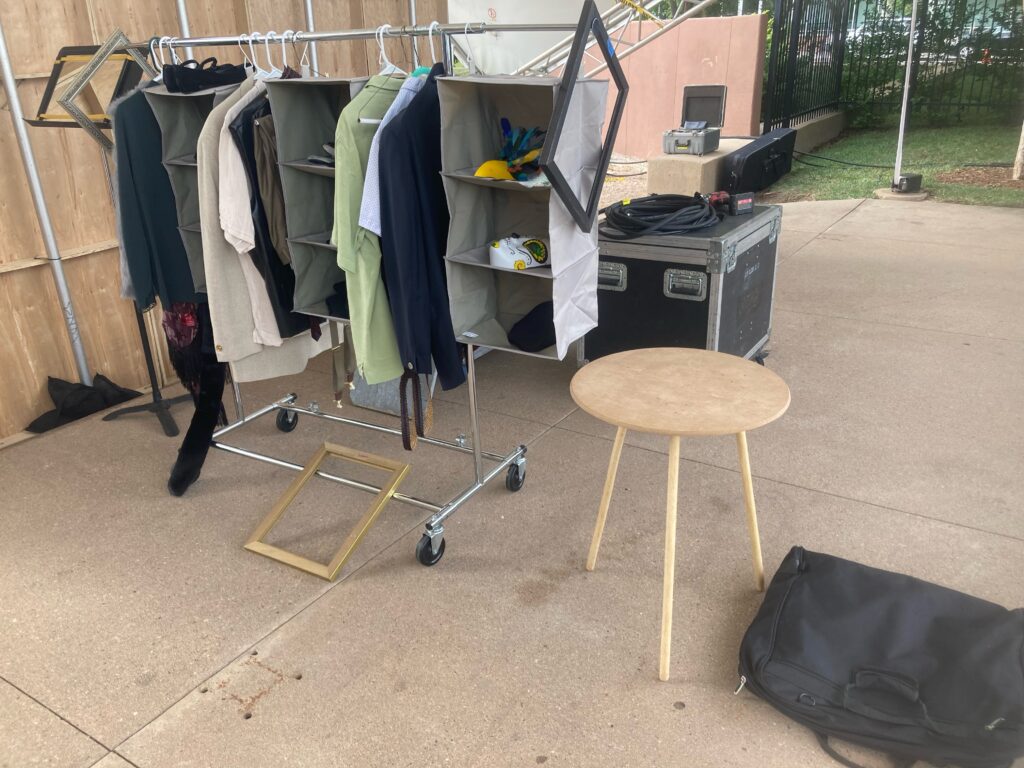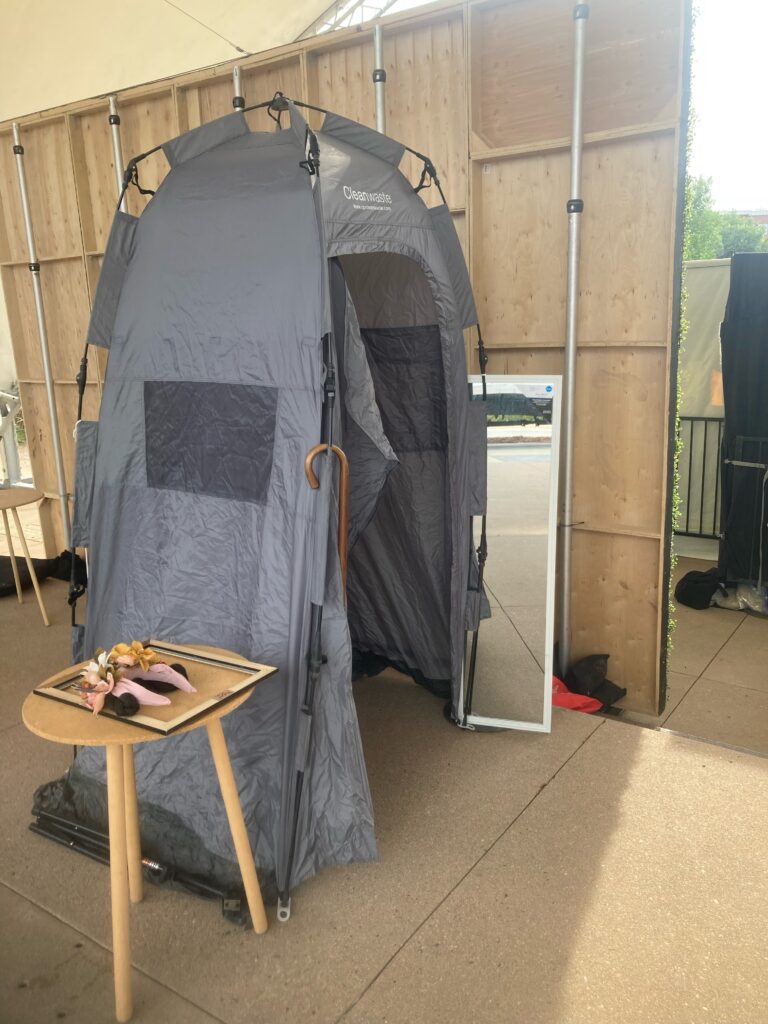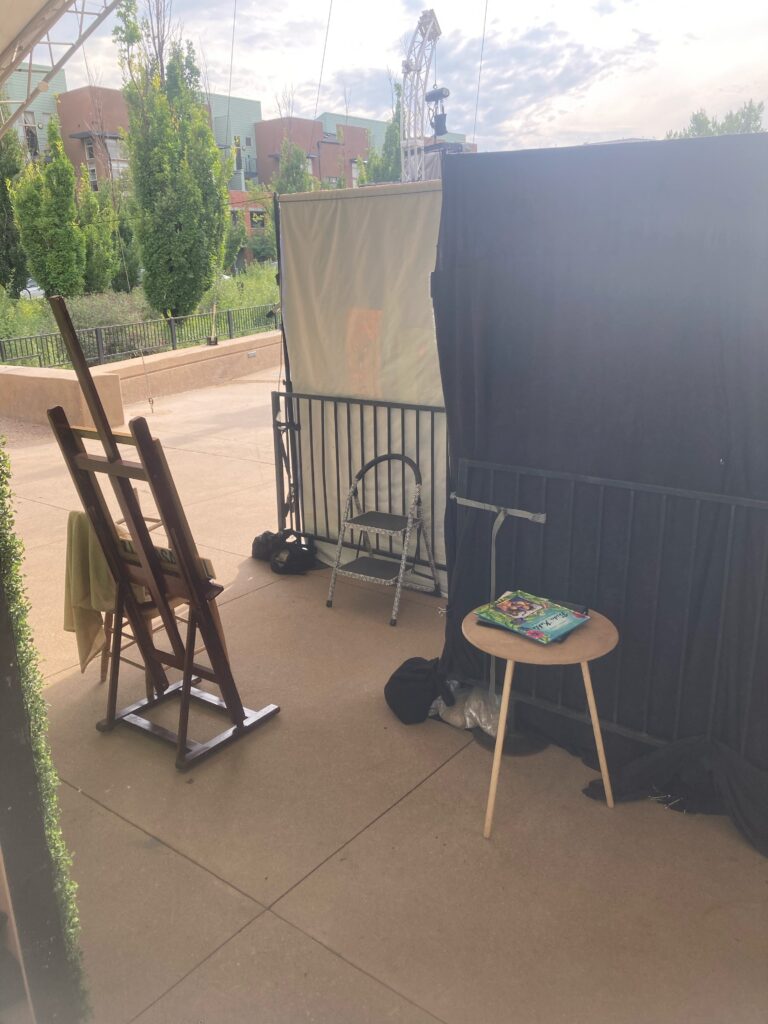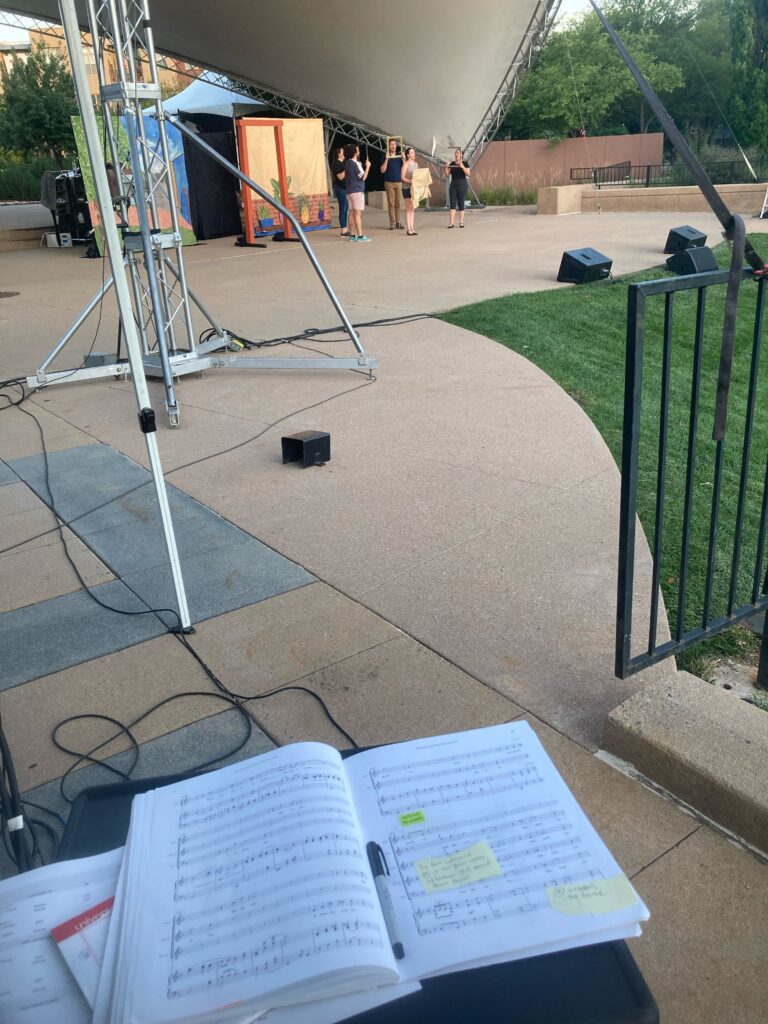This week I’ve had the pleasure to rejoin my Central City Opera Touring Artist friends for a couple of outdoor performances of Frida Kahlo and the Bravest Girl in the World. It’s been a year since I last did a show with them, both of which have been presented as part of MCA’s Opera on the Green late summer performances. In 2021, that was my very first production to return to after our COVID pause, and I loved that it was outside as a way to ease back in. This time around the weather has held off so far, and it’s once again nice for people to be able to see my face while stage managing in the open air. (Some cast members for recent shows basically never saw my face unless on Zoom or outdoors on a break, though they were maskless when performing. I continue to stage manage indoors masked.)
I spent 9 ½ years in the Education & Community department for Central City Opera as Production Manager/Stage Manager for our year-round performances, leaving in 2015 to return to freelancing on full productions. While I’ve very much appreciated the life I’ve led in the years since, it’s nice to go back to this gig and see that I still have some decent ideas about how to go about it. I also adore working with one of my favorite partners-in-crime, Emily Murdock (now the Director of Education). Educational gigs are not like others…there are times where it can be a bit of a “guerilla” performance and you’re not quite sure what your setup will be or who may pay attention to the performance. But there are times like this Friday night where amongst the beach balls flying during the performance there were some enrapt little kiddos clinging to the front fence just enthralled to be part of a question and answer session at the end. (The adults liked it too.) We took over a park in the northern edge of Denver metro, with approximately 250 people watching, who really seemed to enjoy it. Many will be returning for our second performance.
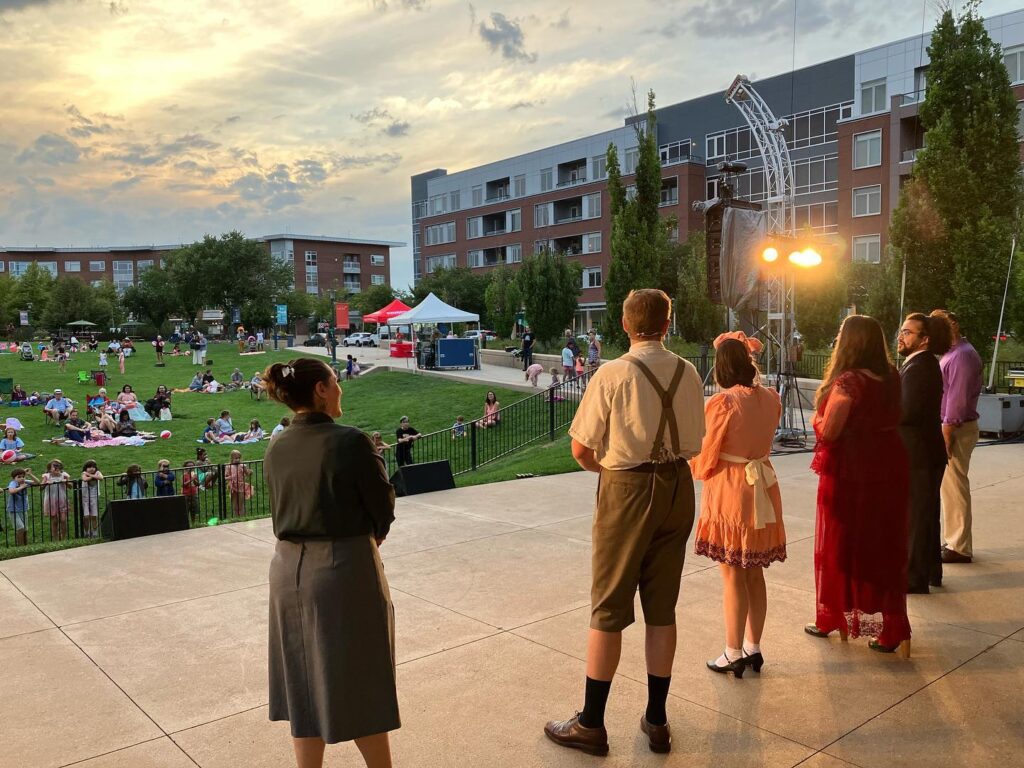
It’s kinda fun to see things that I personally added to the touring setup still being used after all these years, and I have to say, I came up with a couple good solutions. Emily Murdock and Margaret (Meg) Ozaki Graves have continued to improve the setup. See, everything for Education runouts has to fit in a van or two. Collapsible items, and those that can perform double duty (and are sturdy!) are important. Thinking outside the box is important too, as your advance site visit – if you get one – may still not catch everything. And then if you’re outdoors, you add in needing to battle the potential elements, which isn’t something we do that often.
I took a couple photos of our setup to highlight some things we’ve found helpful over the years.
On the far right are two things I contributed years ago, in tandem with our former Director of Education Deb Morrow. That three-legged table has legs that can very easily unscrew, and on a whim in a thrift store one day I realized that I could fit all of the parts – for three of these tables – into that black garment bag that is on the floor beside it. My handy spike tape guide to which parts fit together is still going strong – one set of white spike tape on each leg and the underside of the top, one set green, and one set with larger legs has both green and white on each piece. Not pictured here is that you can buy really nice round tablecloths for them at Bed Bath and Beyond or similar – and suddenly the same table looks very nice next to those ubiquitous gold painted chairs that nearly every opera, rental, or theatre company owns. We had at least three different color sets to choose from by the time I left. In this particular case, we used all three as prop/water stations. Speaking of bags, that may be one of my most lasting legacies for CCO’s Education shows -in addition to the table storage garment bag, I saw various thrifted sports bags I’d bought that had become cases for telescoping PVC pipe frames, a stage management kit and several other items. They are sturdy, and they work. My handwriting was also still all over everything for labels – even the lighting board still had my area lighting listed from the last show!
Collapsible rolling costume racks are another must, and new since last year are that they’ve added in the hanging closet organizers. Each singer has a set of shelves now, which can hold their two masks for instance. Each character’s costumes are also separated between the shelves for easy identification. You gotta have some mirrors backstage. In this case, one is fastened to a music stand. We also own some of those light-up makeup mirrors for when we are in a theatre – the lightup sides to those can also double as a prop table light if placed on the same table. The other handy thing I purchased back then were several rolls of rope light, especially when I could find blue or purple ones. You never know quite where you are going to have trip hazards or outlets, and as long as there is a curtain masking blocking the view, rope light can add safety in a very easy setup.
Because we were performing outdoors in a park, privacy for quickchanges can certainly be an issue. Last year I combined my river guide knowledge with my backstage experience – and I volunteered use of our privacy tent, pictured in gray. While camping, this can either be used to give a secluded spot for the toilet setup, or – as it has no flooring – be rigged up with a shower setup inside. The windows have Velcro to close them – and we found that in this particular show a lightweight flower bouquet could be preset within that “pocket” it created for Frida’s quickchange. A cane can also easily hang off of it for easy grabbing. I couldn’t stake into the concrete, so half a music stand is holding down one side, and the other is tied off to a barricade – more on that soon. The barricade and tent also created a sturdy area to lean our tallest mirror. The tall flat you see is not ours but the venue’s; it looks like a large hedge on the other side.
As for our set, this is one of the shows we do that has a pipe and drape type system. In a gymnasium or theatre, the bases are strong enough to hold up the drops, but we’re outdoors here. Last year we worked on using a whole bunch of sandbags as well as the parachute cord you can see running offstage to keep things from blowing over. This year I spotted these extra barricades that we were allowed to use. I used more of my camping straps to secure our poles to the edges of the barricade, and then weighted all of that down with our numerous sandbags. We also never run out of needs for clamps and binder clips to help secure fabric (especially when it likes to become a sail in the wind).
Because of the expanse of the park, we used microphones for this performance….something opera singers don’t usually use. I had gone through the score I was given (and the video I had followed) to give myself a rough idea of when to bring up area lighting of stage left, center, and stage right (using all of 8 instruments), but I hadn’t thought about needing to cue the new sound person for when mics should be brought up and down. However, since opera tends to be the genre that excels in paperwork, I had a handy who/what/where that I could quickly refer to. It basically had all of my cues right there. We only had five performers. During our dress rehearsal I quickly added in stickers for which mics to bring up and down when they entered and exited, down to the exact measure. We made a couple notes of one offstage entrance and a warning of one really loud section (as well as which scene they entered but didn’t sing), but it was almost flawless the first time. Hooray for opera paperwork! Granted, this is one reason opera does have such great paperwork; we’re often re-mounting something in a short amount of time, and can use the paperwork to plug and play, or to quickly disseminate information to the crew during a condensed tech process. I had never seen a live performance of this opera, as it was a production created after I left, but watching through the video while following the score and the who/what/where definitely got me up to speed very quickly. (Yes, I budgeted that learning time into my contract, too, which was about two hours all told.)
Here was my view during our tech rehearsal. I played around with the few lights (8 of them), called mic cues, and the performers and backstage crew made sure the quickchanges would work, especially because some stairs were involved. That freestanding door unit is PVC pipes that are then skinned with a wood exterior; during setup we brainstormed putting some chain inside the bases to weigh it down. I think that’s now going to be a keeper for them even when inside, though we also added a couple sandbags. That stage left drop you see can also be pulled up to reveal a second one, using a bit of a low-tech roll drop scenario. It’s really a very portable but very pretty set. It looked great behind our opening act Mariachi band too!
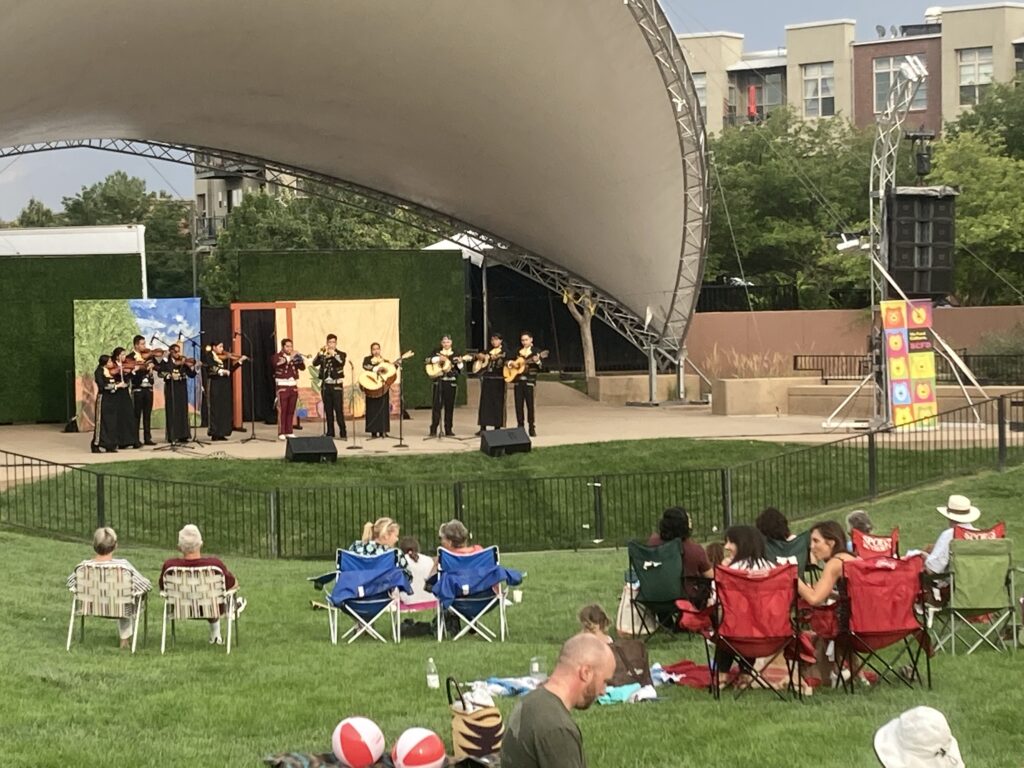
A few other things we didn’t use on this particular opera, but we have handy for runouts include a large tapestry rug (great for fancier adult/family concerts with those tablecloths I mentioned earlier), several fake ficus trees, and a series of four wicker screens. When you change venues all the time, you’re never sure if you’ll have “offstage entrances” or not, or how much space you may need to expand and fill. The screens can be placed at the sides to create some wings/hidden entrances, or two or more can be placed upstage to create your own crossover/backstage area. Add in some ficus trees, floor plants and a stand or too, and some ivy tucked in for good measure (all thrifted pretty easily or found in past props storage), and you can quickly transform a church to look less like Sunday morning, or a wide open theatre into something more inviting. Given a chance to really work with color washes, gobos, or spotlights, those wicker screens can make for some beautiful looks too. We covered the backs and bottoms with extra black fabric to make them a bit more opaque too.
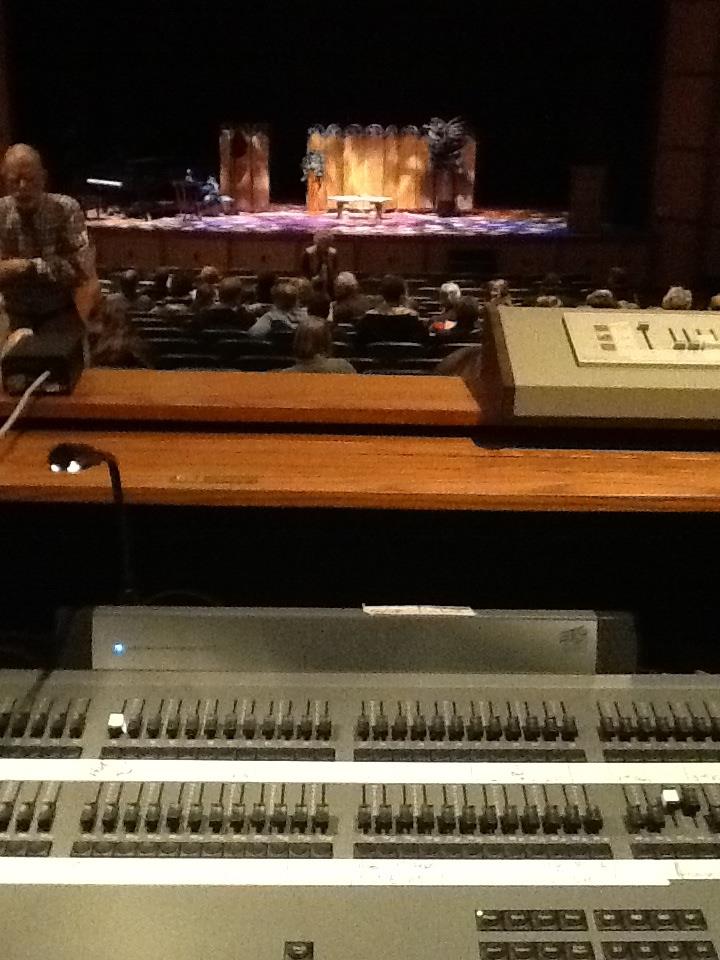
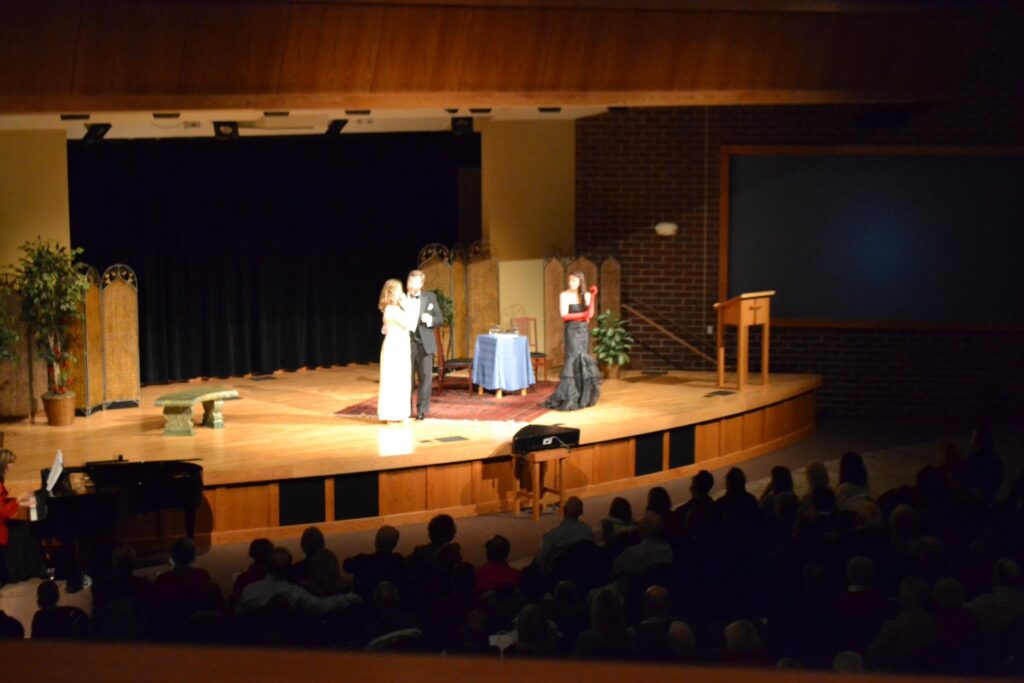
Here’s to hoping the weather continues to hold out for our second performance, though with the overcast we had Friday I actually got to see some of my lighting hit their faces. And it wasn’t quite so blazing hot. Oh, the venue did provide a standing cooler of soft drinks and chilled water. I taught our person backstage that a cold unopened can placed at a knee, elbow or armpit can really help quickly if someone is overheating. Easy-access cooling device! (Thank you, Dad, for teaching me that during high school marching band in wool uniforms.) Thankfully, that knowledge was not needed on site for us. If you really get into performing outdoors, they also make cooling/ice vests that many theatres use under costumes. Our main issue tonight was keeping the mics from getting too sweaty – and planning for a fair amount of laundry between shows.
Addition: My friend Peggy Samuels has done more outdoor performances than I have at this point. When I mentioned writing this blog post, she made sure to mention that Ziploc makes 2.5 gallon bags now. They can fit an entire script (including storing it in the truck that way in case it rains), as well as a computer should it need protection from unexpected weather.
